Quantitative Analysis of Amorphous Silica and Its Influence on Reservoir Properties: A Case Study on the Shale Strata of the Lucaogou Formation in the Jimsar Depression, Junggar Basin, China
Abstract
1. Introduction
2. Geological Settings
3. Materials and Methods
3.1. Materials
3.2. Experimental Method
3.2.1. XRD and XRF Analysis
3.2.2. Rock Mechanics Experiment
3.2.3. Reservoir Physical Properties
3.3. A New Method for Calculating the Content of Amorphous SiO2
4. Results
4.1. Occurrence and Characteristics of Amorphous SiO2
4.2. Composition Characteristics of Crystalline Minerals
4.3. Content of Amorphous SiO2
5. Discussion
5.1. Advantages and Disadvantages of the New Method
5.2. The Influence of Amorphous SiO2 on Reservoir Properties
5.3. Factors Controlling the Conversion of Amorphous SiO2 into Quartz
6. Conclusions
Author Contributions
Funding
Conflicts of Interest
References
- Zhang, J.C.; Xu, B.; Nie, H.K.; Wang, Z.Y.; Lin, T. Exploration potential of shale gas resources in China. Natl. Gas Ind. 2008, 28, 136–140. [Google Scholar]
- Guo, T.L.; Zhang, H.R. Formation and enrichment mode of Jiaoshiba shale gas field, Sichuan Basin. Pet. Explor. Dev. 2014, 41, 31–40. [Google Scholar] [CrossRef]
- Zou, C.; Zhao, Q.; Dong, D.; Yang, Z.; Qiu, Z.; Liang, F.; Wang, N.; Huang, Y.; Duan, A.; Zhang, Q.; et al. Geological characteristics, main challenges and future prospect of shale gas. J. Natl. Gas Geosci. 2017, 2, 273–288. [Google Scholar] [CrossRef]
- Jin, Z.J.; Nie, H.K.; Liu, Q.Y.; Zhao, J.H.; Jiang, T. Source and seal coupling mechanism for shale gas enrichment in upper Ordovician Wufeng Formation—Lower Silurian Longmaxi Formation in Sichuan Basin and its periphery. Mar. Pet. Geol. 2018, 97, 78–93. [Google Scholar] [CrossRef]
- Chen, X.; Fan, J.X.; Wang, W.H.; Wang, H.Y.; Nie, H.K.; Shi, X.W.; Wen, Z.D.; Chen, D.Y.; Li, W.J. Stage-progressive distribution pattern of the Lungmachi black graptolitic shales from Guizhou to Chongqing, Central China. Sci. China Earth Sci. 2017, 60, 1133–1146. [Google Scholar] [CrossRef]
- Bowker, K.A. Barnett Shale gas production, Fort Worth Basin: Issues and discussion. AAPG Bull. 2007, 91, 523–533. [Google Scholar] [CrossRef]
- Jarvie, D.M.; Hill, R.J.; Ruble, T.E.; Pollastro, R.M. Unconventional shale-gas systems: The Mississippian Barnett shale of north-central Texas as one model for thermo-genic shale-gas assessment. AAPG Bull. 2007, 91, 475–499. [Google Scholar] [CrossRef]
- Ruyue, W.; Wenlong, D.; Dajian, G.; Jigao, L.; Xinghua, W.; Shuai, Y. Gas preservation conditions of marine shale in northern Guizhou area: A case study of the Lower Cambrian Niutitang Formation in the Cen’gong block, Guizhou Province. Oil Gas Geol. 2016, 37, 45–55. [Google Scholar]
- Wang, R.; Hu, Z.; Sun, C.; Liu, Z.; Zhang, C.; Gao, B.; Du, W.; Zhao, J.; Tang, W. Comparative analysis and discussion of shale reservoir characteristics in the Wufeng-Longmaxi and Niutitang formations. Pet. Geol. Exp. 2018, 40, 639–649. [Google Scholar]
- Dong, T.; Harris, N.B.; Ayranci, K.; Yang, S. The impact of rock composition on geomechanical properties of a shale formation: Middle and Upper Devonian Horn River Group shale, Northeast British Columbia, Canada. AAPG Bull. 2017, 101, 177–204. [Google Scholar] [CrossRef]
- Guo, X.S.; Hu, D.F.; Wen, Z.D.; Liu, R.B. Major factors controlling the accumulation and high productivity in marine shale gas in the Lower Paleozoic of Sichuan Basin and its periphery: A case study of the Wufeng-Longmaxi Formation of Jiaoshiba area. Geol. China 2014, 41, 893–901. [Google Scholar]
- Lu, L.; Qin, J.; Shen, B.; Teng, G.; Liu, W.; Zhang, Q. Biogenic origin and hydrocarbon significance of siliceous shale from the Wufeng-Longmaxi formations in Fuling area, southeastern Sichuan Basin. Pet. Geol. Exp. 2016, 38, 460–472. [Google Scholar]
- Lu, L.; Qin, J.; Shen, B.; Teng, G.; Liu, W.; Zhang, Q. The origin of biogenic silica in siliceous shale from Wufeng-Longmaxi Formation in the Middle and Upper Yangtze region and its relationship with shale gas enrichment. Earth Sci. Front. 2018, 25, 226–236. [Google Scholar]
- Zhao, J.; Jin, Z.; Jin, Z.; Wen, X.; Geng, Y.K.; Yan, C.N. The genesis of quartz in Wufeng-Longmaxi gas shales, Sichuan Basin. Natl. Gas Geosci. 2016, 27, 377–386. [Google Scholar]
- Wang, S.; Zou, C.; Dong, D.; Wang, Y.; Huang, J.; Guo, Z. Biogenic silica of organic-rich shale in Sichuan Basin and its significance for shale gas. Acta Sci. Nat. Univ. Pekin. 2014, 50, 476–486. [Google Scholar]
- Liu, G.; Zhai, G.; Zou, C.; Cheng, L.; Guo, X.; Xia, X.; Shi, D.; Yang, Y.; Zhang, C.; Zhou, Z. A comparative discussion of the evidence for biogenic silica in Wufeng-Longmaxi siliceous shale reservoir in the Sichuan basin, China. Mar. Pet. Geol. 2019, 109, 70–87. [Google Scholar] [CrossRef]
- Liu, G.; Zhai, G.; Huang, Z.; Zou, C.; Xia, X.; Shi, D.; Zhou, Z.; Zhang, C.; Chen, R.; Yu, S.; et al. The effect of tuffaceous material on characteristics of different lithofacies: A case study on Lucaogou Formation fine-grained sedimentary rocks in Santanghu Basin. J. Pet. Sci. Eng. 2019, 179, 355–377. [Google Scholar] [CrossRef]
- Xianzheng, Z.H.; Lihong, Z.H.; Xiugang, P.U.; Fengming, J.; Wenzhong, H.; Dunqing, X.; Shiyue, C.H.; Zhannan, S.H.; Zhang, W.; Fei, Y.A. Geological characteristics of shale rock system and shale oil exploration breakthrough in a lacustrine basin: A case study from the Paleogene 1st sub-member of Kong 2 Member in Cangdong sag, Bohai Bay Basin, China. Pet. Explor. Dev. 2018, 45, 377–388. [Google Scholar]
- Liu, G.; Liu, B.; Huang, Z.; Chen, Z.; Jiang, Z.; Guo, X.; Li, T.; Chen, L. Hydrocarbon distribution pattern and logging identification in lacustrine fine-grained sedimentary rocks of the Permian Lucaogou Formation from the Santanghu basin. Fuel 2018, 222, 207–231. [Google Scholar] [CrossRef]
- Liu, G.H.; Huang, Z.L.; Guo, X.B.; Liu, Z.Z.; Gao, X.Y.; Chen, C.C.; Zhang, C.L. The research of SiO2 occurrence in mud shale reservoir of the Yanchang formation in Ordos Basin. Acta Geol. Sin. 2016, 90, 1016–1029. [Google Scholar]
- Liu, G.H.; Huang, Z.L.; Guo, X.B.; Liu, Z.Z.; Gao, X.Y.; Chen, C.C.; Zhang, C.L. The SiO2 occurrence and origin in the shale system of middle Permian series Lucaogou Formation in Malang Sag, Santanghu Basin, Xinjiang. Acta Geol. Sin. 2016, 90, 1220–1235. [Google Scholar]
- Huang, Z.; Liu, G.; Li, T.; Li, Y.; Yin, Y.; Wang, L. Characterization and control of mesopore structural heterogeneity for low thermal maturity shale: A case study of Yanchang Formation shale, Ordos Basin. Energy Fuels 2017, 31, 11569–11586. [Google Scholar] [CrossRef]
- Zhao, J.; Jin, Z.; Jin, Z.; Hu, Q.; Hu, Z.; Du, W.; Yan, C.; Geng, Y. Mineral types and organic matters of the Ordovician-Silurian Wufeng and Longmaxi Shale in the Sichuan Basin, China: Implications for pore systems, diagenetic pathways, and reservoir quality in fine-grained sedimentary rocks. Mar. Pet. Geol. 2017, 86, 655–674. [Google Scholar] [CrossRef]
- Zhao, J.; Jin, Z.; Jin, Z.; Wen, X.; Geng, Y. Origin of authigenic quartz in organic-rich shales of the Wufeng and Longmaxi Formations in the Sichuan Basin, South China: Implications for pore evolution. J. Natl. Gas Sci. Eng. 2017, 38, 21–38. [Google Scholar] [CrossRef]
- Zhang, L.; Li, B.; Jiang, S.; Xiao, D.; Lu, S.; Zhang, Y.; Gong, C.; Chen, L. Heterogeneity characterization of the lower Silurian Longmaxi marine shale in the Pengshui area, South China. Int. J. Coal Geol. 2018, 195, 250–266. [Google Scholar] [CrossRef]
- Peltonen, C.; Marcussen, Ø.; Bjørlykke, K.; Jahren, J. Clay mineral diagenesis and quartz cementation in mudstones: The effects of smectite to illite reaction on rock properties. Mar. Pet. Geol. 2009, 26, 887–898. [Google Scholar] [CrossRef]
- Thyberg, B.; Jahren, J.; Winje, T.; Bjørlykke, K.; Faleide, J.I.; Marcussen, Ø. Quartz cementation in Late Cretaceous mudstones, northern North Sea: Changes in rock properties due to dissolution of smectite and precipitation of microquartz crystals. Mar. Pet. Geol. 2010, 27, 1752–1764. [Google Scholar] [CrossRef]
- Thyberg, B.; Jahren, J. Quartz cementation in mudstones: Sheet-like quartz cement from clay mineral reactions during burial. Pet. Geosci. 2011, 17, 53–63. [Google Scholar] [CrossRef]
- Chaika, C.; Williams, L.A. Density and mineralogy variations as a function of porosity in Miocene Monterey Formation oil and gas reservoirs in California. AAPG Bull. 2001, 85, 149–167. [Google Scholar]
- Lin, J.H. Quantitative analysis of amorphous silica in multicomponent system by X-ray diffraction. J. Mineral. Petrol. 1997, 17, 22–25. [Google Scholar]
- Liu, G.H. The Formation Mechanism of Authigenic Quartz in Lacustrine Shale and Influence to Reservoir Property [D]. Ph.D. Thesis, China University of Petroleum, Beijing, China, 2017. [Google Scholar]
- Chu, G. A Doping Method for Quantitative X-Ray Diffraction Phase Analysis of Samples Containing Amorphous Material. Acta Phys. Sin. 1998, 47, 1143–1148. [Google Scholar]
- Popović, S.; Gržeta-plenković, B.; Balić-žunić, T. The doping method in quantitative x-ray diffraction pahase analysis addendum. J. Appl. Crystallogr. 1983, 16, 505–507. [Google Scholar] [CrossRef]
- Huang, Z.; Liu, G.; Ma, J.; Xue, D.; Han, W.; Chen, J.; Chen, Z. A new method for semiquantitative analysis of amorphous SiO2 in terrestrial shale: A case study about Yanchang Formation shale, Ordos Basin. Natl. Gas Geosci. 2015, 26, 2017–2028. [Google Scholar]
- Cao, Z.; Liu, G.; Kong, Y.; Wang, C.; Niu, Z.; Zhang, J.; Wei, Z. Lacustrine tight oil accumulation characteristics: Permian Lucaogou Formation in jimusaer sag, Junggar Basin. Int. J. Coal Geol. 2016, 153, 37–51. [Google Scholar] [CrossRef]
- Qu, C.S.; Qiu, L.W.; Cao, Y.C. Organic petrology characteristics and occurrence of source rocks in Permian Lucaogou Formation, Jimsar sag. J. China Univ. Pet. (Ed. Natl. Sci.) 2017, 41, 30–38. [Google Scholar]
- Zhou, D.W.; Liu, Y.Q.; Xing, X.J.; Hao, J.R.; Dong, Y.P.; Ouyang, Z.J. Formation of the Permian basalts and implications of geochemical tracing for paleo-tectonic setting and regional tectonic background in the Turpan-Hami and Santanghu basins, Xinjiang. Sci. China Ser. D 2006, 49, 584–596. [Google Scholar] [CrossRef]
- Jiang, Y.Q.; Liu, Y.Q.; Zhao, Y.; Nan, Y.; Wang, R.; Zhou, P.; Yang, Y.J.; Kou, J.Y.; Zhou, N.C. Characteristics and origin of tuff-type tight oil in Jimusar sag, Junggar Basin, NW China. Pet. Explor. Dev. 2015, 42, 810–818. [Google Scholar] [CrossRef]
- Wang, J.; Zhou, L.; Liu, J.; Zhang, X.J.; Zhang, F.; Zhang, B. Acid-base alternation diagenesis and its influence on shale reservoirs in the Permian Lucaogou Formation, Jimusar Sag, Junggar Basin, NW China. Pet. Explor. Dev. 2020, 47, 962–976. [Google Scholar] [CrossRef]
- Liu, C.; Liu, K.; Wang, X.; Wu, L.; Fan, Y. Chemostratigraphy and sedimentary facies analysis of the Permian Lucaogou Formation in the Jimusaer Sag, Junggar Basin, NW China: Implications for tight oil exploration. J. Asian Earth Sci. 2019, 178, 96–111. [Google Scholar] [CrossRef]
- Wang, C.Y.; Kuang, L.C.; Gao, G.; Cui, W.; Kong, Y.H.; Xiang, B.L.; Liu, G.D. Difference in hydrocarbon generation potential of the shaly source rocks in Jimusar sag` Permian Lucaogou formation. Acta Sedimentol. Sin. 2014, 32, 385–390. [Google Scholar]
- Zhi, Y.; Lianhua, H.; Senhu, L.; Xia, L.; Lijun, Z.; Songtao, W.; Jingwei, C. Geologic characteristics and exploration potential of tight oil and shale oil in Lucaogou formation in Jimsar sag. China Pet. Explor. 2018, 23, 76–85. [Google Scholar]
- Cai, D.M.; Sun, L.D.; Qi, J.S.; Dong, J.H.; Zhu, Y.K. Reservoir characteristics and evolution of volcanic rocks in Xujiaweizi fault depression. Acta Pet. Sin. 2010, 31, 400–407. [Google Scholar]
- Hu, W.T.; Liu, C.Z.; Zhao, H.; Luan, K.; Yao, H.P. The Diagenesis of Volcanic Rocks and Its Effects on the Reservior Quality in Xujiaweizi Fault Depression, Soliao Basin. Sci. Technol. Eng. 2011, 11, 1176–1181. [Google Scholar]
- Yang, J.S.; Meng, Y.L.; Zhang, H. Kinetic model of quartz cementation and its application. Pet. Geol. Exp. 2002, 24, 372–376. [Google Scholar]
- Yuan, D.S.; Zhang, Z.H.; Zhu, L.; Liu, H.J. Effects of oil charge on quartz cement. Acta Petrol. Sin. 2007, 23, 2315–2320. [Google Scholar]
- Li, R.; Ge, Y.J.; Chen, Y.; Zhou, Y.Q.; Zhou, H.J. Experimental evidence of influential factor of quartz growth in reservoir. J. China Univ. Pet. 2010, 34, 13–18. [Google Scholar]
- Yuanlin, M.; Cheng, X.; Hongyu, X.; Weizhi, T.; Chuanxin, T.; Jinghuan, L.; Youchun, W.A.; Yuting, G.A. A new kinetic model for authigenic quartz formation under overpressure. Pet. Explor. Dev. 2013, 40, 701–707. [Google Scholar]
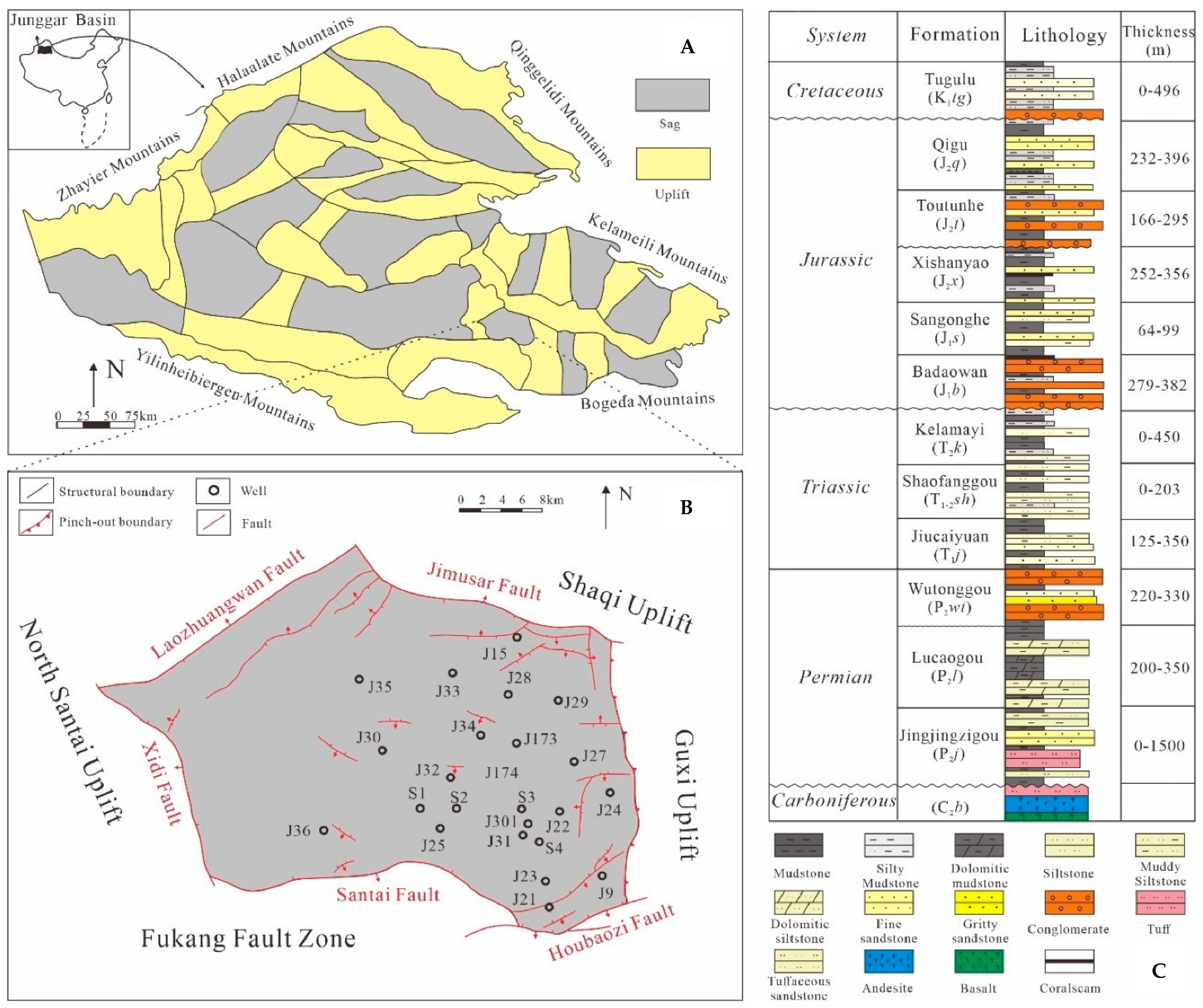
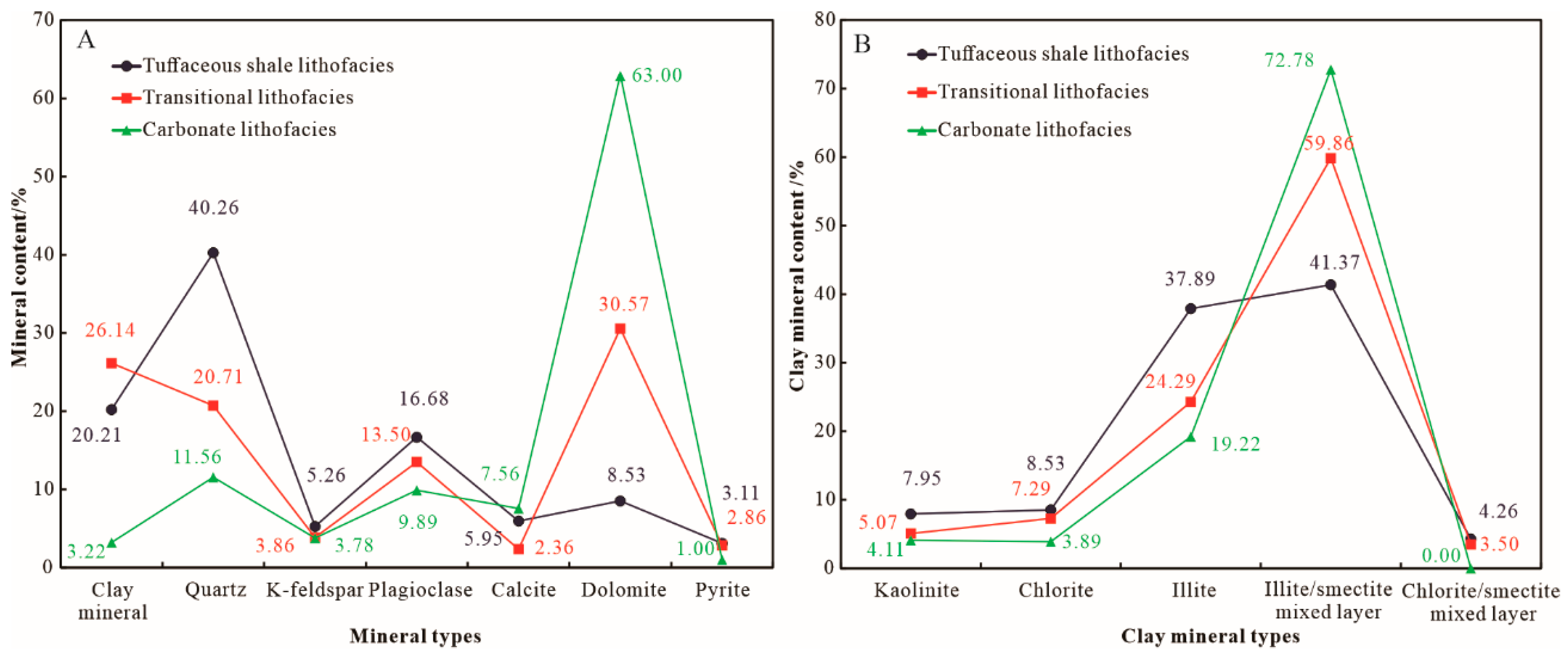
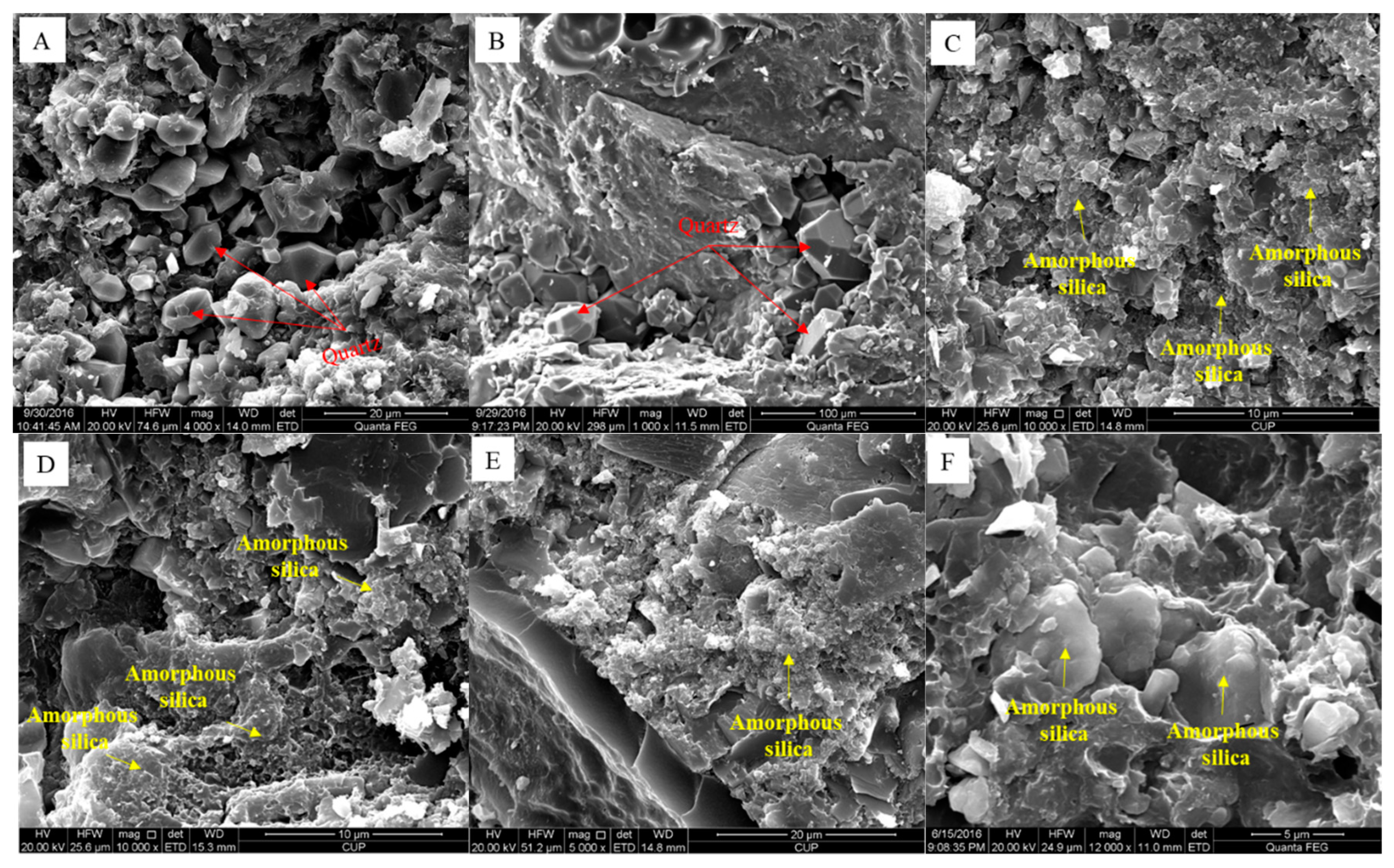

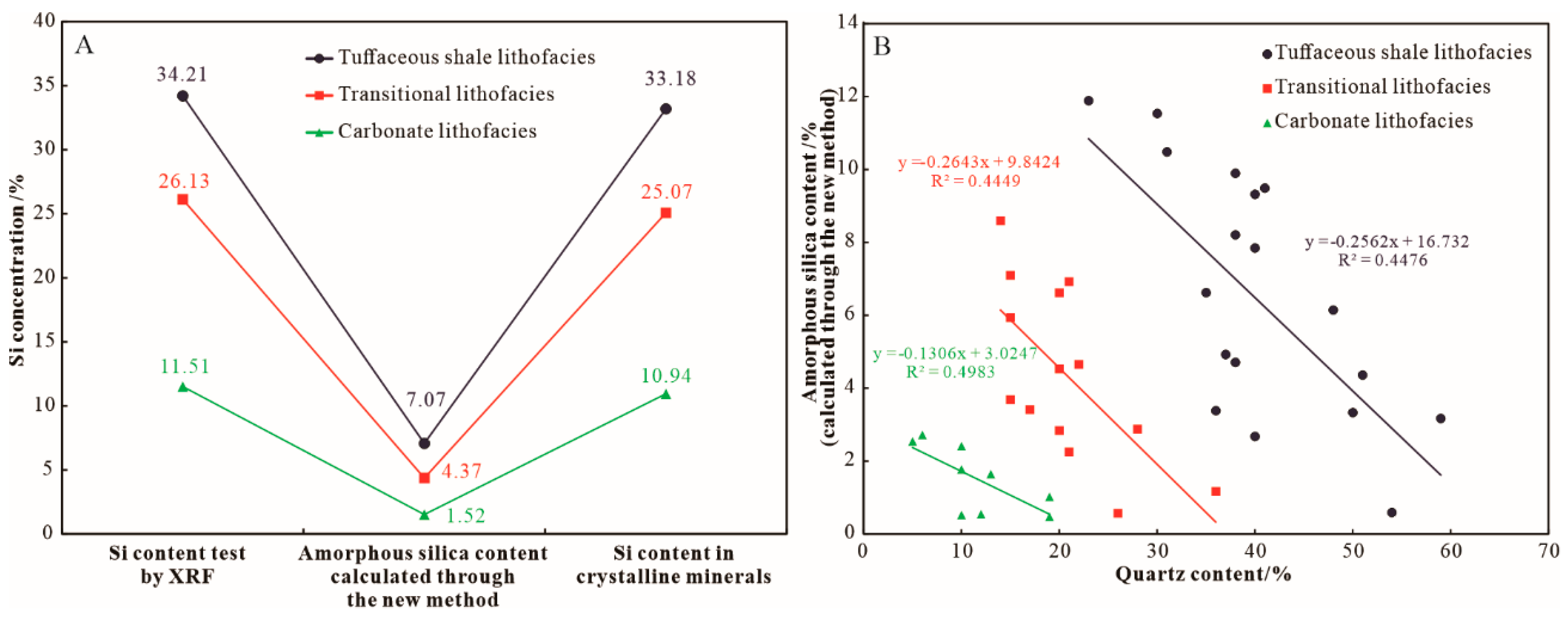

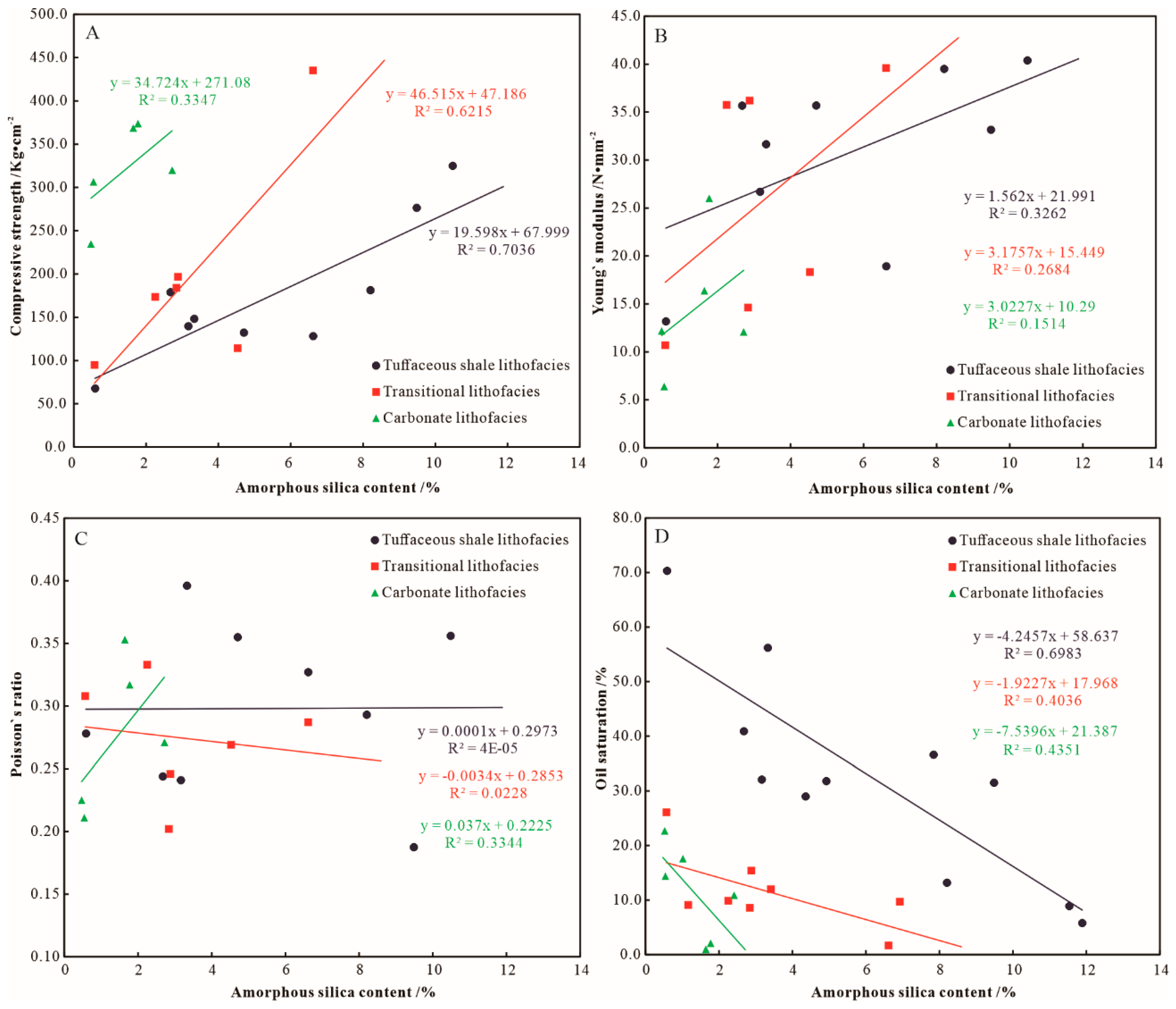
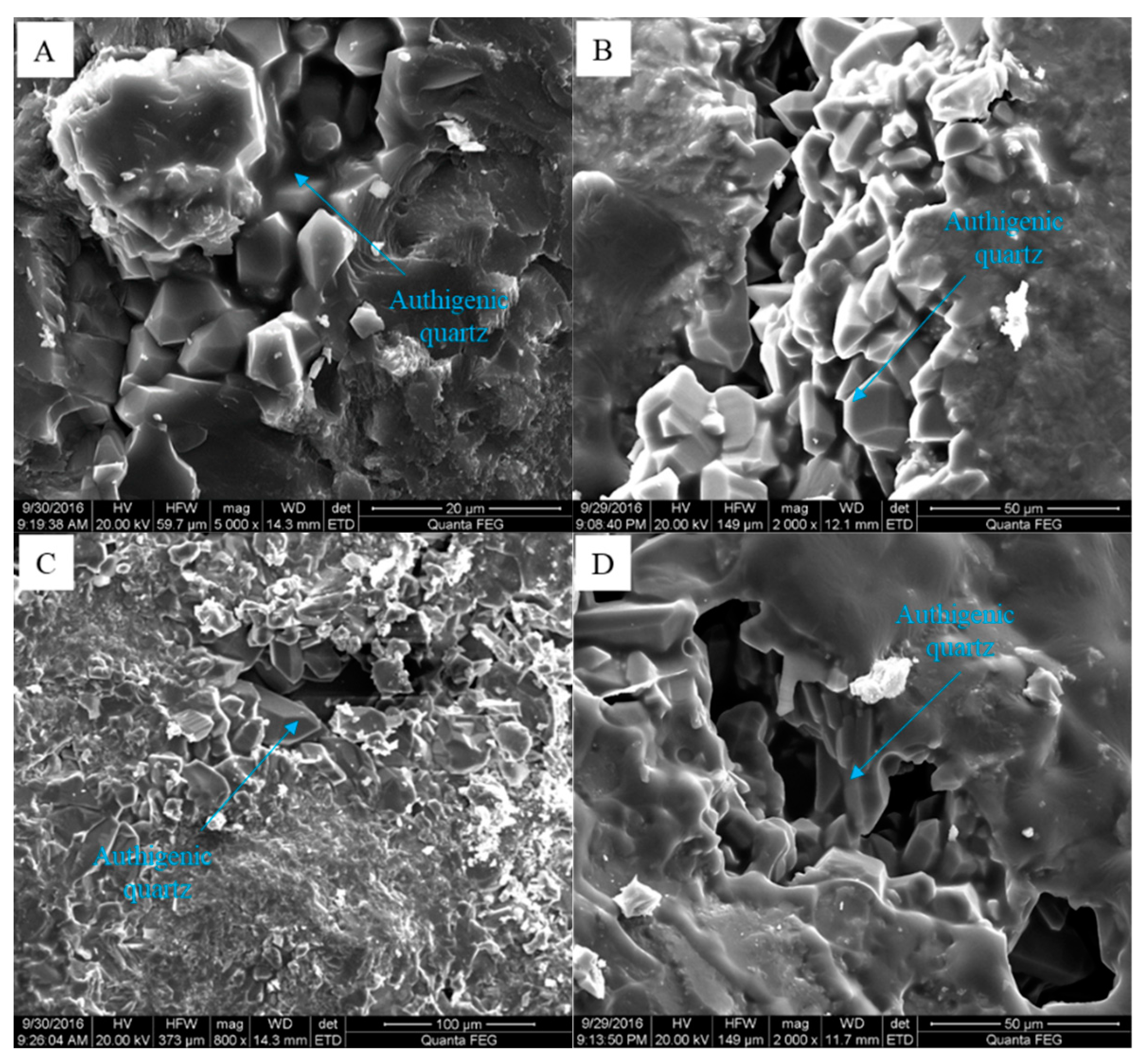
| Well | Depth (m) | Lithofacies | Clay Mineral/% | Quartz/% | K-Feldspar /% | Plagioclase/% | Calcite/% | Dolomite/% | Pyrite/% | Kaolinite/% | Chlorite/% | Illite/% | Illite/Smectite Mixed Layers/% | Chlorite/Smectite Mixed Layers/% | Illite/Smectite mixed Layer RATIO/% | Chlorite/Smectite Mixed Layers Ratio/% |
|---|---|---|---|---|---|---|---|---|---|---|---|---|---|---|---|---|
| S1 | 3063.80 | Carbonate lithofacies | 5 | 19 | 4 | 3 | 8 | 61 | 0 | 5 | 6 | 15 | 74 | 0 | 55 | 0 |
| S1 | 3086.50 | Carbonate lithofacies | 2 | 10 | 4 | 5 | 0 | 79 | 0 | 0 | 0 | 50 | 50 | 0 | 56 | 0 |
| S1 | 3136.85 | Transitional lithofacies | 28 | 22 | 0 | 13 | 3 | 34 | 0 | 8 | 9 | 16 | 67 | 0 | 70 | 0 |
| S1 | 3147.64 | Transitional lithofacies | 31 | 21 | 4 | 8 | 0 | 33 | 3 | 25 | 29 | 14 | 32 | 0 | 44 | 0 |
| S1 | 3149.00 | Carbonate lithofacies | 2 | 5 | 6 | 3 | 0 | 81 | 3 | 3 | 3 | 14 | 80 | 0 | 57 | 0 |
| S2 | 3343.00 | Tuffaceous shale lithofacies | 22 | 23 | 5 | 22 | 0 | 25 | 3 | 0 | 0 | 64 | 36 | 0 | 40 | 0 |
| S2 | 3315.00 | Carbonate lithofacies | 3 | 12 | 0 | 18 | 13 | 53 | 1 | 5 | 4 | 10 | 81 | 0 | 50 | 0 |
| S2 | 3323.00 | Transitional lithofacies | 23 | 28 | 0 | 17 | 3 | 27 | 2 | 0 | 6 | 10 | 35 | 49 | 67 | 60 |
| S2 | 3332.00 | Carbonate lithofacies | 2 | 13 | 0 | 18 | 5 | 60 | 2 | 9 | 6 | 9 | 76 | 0 | 49 | 0 |
| S2 | 3344.00 | Transitional lithofacies | 17 | 17 | 9 | 12 | 7 | 35 | 3 | 0 | 11 | 24 | 65 | 0 | 56 | 0 |
| S2 | 3347.00 | Transitional lithofacies | 39 | 26 | 0 | 10 | 10 | 12 | 3 | 0 | 7 | 15 | 78 | 0 | 55 | 0 |
| S2 | 3348.08 | Tuffaceous shale lithofacies | 22 | 31 | 8 | 12 | 0 | 23 | 4 | 0 | 0 | 85 | 15 | 0 | 40 | 0 |
| S2 | 3351.66 | Carbonate lithofacies | 2 | 19 | 0 | 10 | 24 | 45 | 0 | 4 | 4 | 32 | 60 | 0 | 52 | 0 |
| S2 | 3353.14 | Carbonate lithofacies | 2 | 10 | 1 | 14 | 2 | 71 | 0 | 8 | 9 | 28 | 55 | 0 | 56 | 0 |
| S2 | 3355.13 | Transitional lithofacies | 32 | 21 | 0 | 11 | 0 | 33 | 3 | 0 | 0 | 43 | 57 | 0 | 54 | 0 |
| S2 | 3359.95 | Transitional lithofacies | 22 | 14 | 8 | 14 | 6 | 36 | 0 | 2 | 2 | 81 | 15 | 0 | 67 | 0 |
| S2 | 3379.55 | Transitional lithofacies | 23 | 20 | 7 | 16 | 4 | 25 | 5 | 0 | 8 | 9 | 83 | 0 | 61 | 0 |
| S2 | 3380.01 | Tuffaceous shale lithofacies | 16 | 48 | 11 | 20 | 0 | 0 | 5 | 12 | 15 | 0 | 73 | 0 | 90 | 0 |
| S2 | 3463.00 | Transitional lithofacies | 27 | 15 | 6 | 14 | 0 | 36 | 2 | 0 | 0 | 38 | 62 | 0 | 51 | 0 |
| S2 | 3477.00 | Transitional lithofacies | 26 | 20 | 9 | 14 | 0 | 28 | 3 | 0 | 7 | 13 | 80 | 0 | 65 | 0 |
| S2 | 3600.34 | Carbonate lithofacies | 4 | 10 | 9 | 8 | 6 | 60 | 3 | 3 | 3 | 15 | 79 | 0 | 49 | 0 |
| S3 | 2794.71 | Tuffaceous shale lithofacies | 18 | 40 | 4 | 21 | 12 | 4 | 1 | 13 | 15 | 9 | 63 | 0 | 87 | 0 |
| S3 | 2795.80 | Tuffaceous shale lithofacies | 14 | 59 | 3 | 4 | 8 | 12 | 0 | 0 | 0 | 80 | 20 | 0 | 40 | 0 |
| S3 | 2805.21 | Transitional lithofacies | 12 | 15 | 0 | 27 | 0 | 43 | 3 | 5 | 6 | 0 | 89 | 0 | 70 | 0 |
| S3 | 2808.52 | Carbonate lithofacies | 7 | 6 | 10 | 10 | 10 | 57 | 0 | 0 | 0 | 0 | 100 | 0 | 52 | 0 |
| S3 | 2815.21 | Tuffaceous shale lithofacies | 27 | 30 | 9 | 18 | 6 | 5 | 5 | 0 | 0 | 94 | 6 | 0 | 40 | 0 |
| S3 | 2817.81 | Tuffaceous shale lithofacies | 18 | 54 | 0 | 17 | 4 | 4 | 3 | 11 | 12 | 8 | 69 | 0 | 89 | 0 |
| S3 | 2832.89 | Tuffaceous shale lithofacies | 22 | 38 | 7 | 10 | 19 | 1 | 3 | 0 | 0 | 98 | 2 | 0 | 40 | 0 |
| S3 | 2857.65 | Tuffaceous shale lithofacies | 22 | 40 | 13 | 15 | 3 | 2 | 5 | 0 | 0 | 95 | 5 | 0 | 40 | 0 |
| S3 | 2869.14 | Tuffaceous shale lithofacies | 23 | 38 | 8 | 5 | 0 | 26 | 0 | 0 | 0 | 86 | 14 | 0 | 40 | 0 |
| S3 | 2870.01 | Tuffaceous shale lithofacies | 19 | 37 | 10 | 15 | 5 | 11 | 3 | 23 | 18 | 0 | 59 | 0 | 85 | 0 |
| S3 | 2871.01 | Tuffaceous shale lithofacies | 18 | 35 | 13 | 23 | 3 | 4 | 4 | 14 | 17 | 0 | 69 | 0 | 88 | 0 |
| S3 | 2873.01 | Tuffaceous shale lithofacies | 18 | 36 | 0 | 26 | 6 | 11 | 3 | 15 | 14 | 6 | 65 | 0 | 83 | 0 |
| S3 | 2874.01 | Tuffaceous shale lithofacies | 23 | 38 | 0 | 26 | 4 | 5 | 4 | 14 | 16 | 0 | 70 | 0 | 86 | 0 |
| S3 | 2876.81 | Tuffaceous shale lithofacies | 22 | 41 | 0 | 19 | 6 | 9 | 3 | 8 | 7 | 4 | 0 | 81 | 0 | 50 |
| S4 | 2580.81 | Transitional lithofacies | 25 | 20 | 0 | 16 | 0 | 37 | 2 | 12 | 11 | 49 | 28 | 0 | 40 | 0 |
| S4 | 2585.01 | Transitional lithofacies | 21 | 15 | 8 | 14 | 0 | 37 | 5 | 4 | 6 | 28 | 62 | 0 | 59 | 0 |
| S4 | 2591.91 | Tuffaceous shale lithofacies | 21 | 51 | 0 | 13 | 8 | 5 | 2 | 13 | 16 | 4 | 67 | 0 | 86 | 0 |
| S4 | 2592.21 | Tuffaceous shale lithofacies | 26 | 36 | 0 | 26 | 0 | 9 | 3 | 16 | 18 | 6 | 60 | 0 | 86 | 0 |
| S4 | 2601.21 | Tuffaceous shale lithofacies | 17 | 50 | 3 | 15 | 8 | 3 | 4 | 12 | 14 | 7 | 67 | 0 | 86 | 0 |
| S4 | 2601.81 | Tuffaceous shale lithofacies | 16 | 40 | 6 | 10 | 21 | 3 | 4 | 0 | 0 | 74 | 26 | 0 | 40 | 0 |
| S4 | 2607.60 | Transitional lithofacies | 40 | 36 | 3 | 3 | 0 | 12 | 6 | 15 | 0 | 0 | 85 | 0 | 60 | 0 |
| Well | Depth (m) | Lithofacies | Oil Saturation/% | Young’s Modulus/N*mm−2 | Poisson’s Ratio | Compressive Strength/Kg*cm−2 | Porosity/% | Permeability/mD | Si Content Test by XRF/% | Amorphous Silica Content Calculated Through the New Method/% | Calculated Si Content in Crystalline Minerals/% | Calculated Si Content in Clay Minerals/% |
|---|---|---|---|---|---|---|---|---|---|---|---|---|
| S1 | 3063.80 | Carbonate lithofacies | 17.6 | -- | -- | -- | -- | -- | 13.535 | 1.017 | 13.184 | 40.196 |
| S1 | 3086.50 | Carbonate lithofacies | 10.9 | -- | -- | -- | 0.7041 | 0.0013 | 9.197 | 2.410 | 8.246 | 38.156 |
| S1 | 3136.85 | Transitional lithofacies | -- | -- | -- | -- | -- | -- | 26.937 | 4.652 | 25.924 | 41.131 |
| S1 | 3147.64 | Transitional lithofacies | 9.70 | -- | -- | -- | 0.2367 | 0.0000923 | 24.348 | 6.921 | 22.612 | 28.963 |
| S1 | 3149.00 | Carbonate lithofacies | -- | -- | -- | -- | 0.6041 | 0.00215 | 7.013 | 2.540 | 5.939 | 41.964 |
| S2 | 3343.00 | Tuffaceous shale lithofacies | 5.80 | -- | -- | -- | 0.5851 | 0.000043 | 29.234 | 11.885 | 26.743 | 34.728 |
| S2 | 3315.00 | Carbonate lithofacies | 14.4 | 6.396 | 0.211 | 306.527 | -- | -- | 12.545 | 0.542 | 12.353 | 40.376 |
| S2 | 3323.00 | Transitional lithofacies | 15.40 | 36.212 | 0.246 | 196.722 | -- | -- | 25.334 | 2.878 | 24.671 | 26.948 |
| S2 | 3332.00 | Carbonate lithofacies | 1 | 16.381 | 0.353 | 368.663 | 1.1986 | 0.01 | 12.978 | 1.643 | 12.398 | 38.948 |
| S2 | 3344.00 | Transitional lithofacies | 12.00 | -- | -- | -- | -- | -- | 21.979 | 3.412 | 21.070 | 39.007 |
| S2 | 3347.00 | Transitional lithofacies | 26.10 | 10.707 | 0.308 | 94.94 | -- | -- | 31.536 | 0.570 | 31.443 | 41.105 |
| S2 | 3348.08 | Tuffaceous shale lithofacies | -- | 40.386 | 0.356 | 324.954 | -- | -- | 30.056 | 10.484 | 27.990 | 32.612 |
| S2 | 3351.66 | Carbonate lithofacies | -- | 12.181 | 0.225 | 234.695 | 0.9727 | 0.00236 | 13.028 | 0.472 | 12.836 | 38.126 |
| S2 | 3353.14 | Carbonate lithofacies | 22.7 | -- | -- | -- | -- | -- | 10.224 | 0.522 | 10.027 | 37.074 |
| S2 | 3355.13 | Transitional lithofacies | 9.90 | 35.739 | 0.333 | 173.612 | -- | -- | 26.256 | 2.251 | 25.762 | 38.856 |
| S2 | 3359.95 | Transitional lithofacies | -- | -- | -- | -- | -- | -- | 22.943 | 8.594 | 20.615 | 33.214 |
| S2 | 3379.55 | Transitional lithofacies | 8.60 | 14.625 | 0.202 | 184.049 | 26.952 | 2.838 | 26.346 | 42.938 | ||
| S2 | 3380.01 | Tuffaceous shale lithofacies | -- | -- | -- | -- | -- | -- | 39.916 | 6.143 | 39.407 | 44.803 |
| S2 | 3463.00 | Transitional lithofacies | -- | -- | -- | -- | 0.4650 | 0.0109 | 25.431 | 7.099 | 23.729 | 39.068 |
| S2 | 3477.00 | Transitional lithofacies | -- | 18.328 | 0.269 | 114.190 | 1.1957 | 0.135 | 28.659 | 4.529 | 27.756 | 43.399 |
| S2 | 3600.34 | Carbonate lithofacies | 2.10 | 26.013 | 0.317 | 373.744 | -- | -- | 12.147 | 1.773 | 11.505 | 40.227 |
| S3 | 2794.71 | Tuffaceous shale lithofacies | 40.90 | 35.675 | 0.244 | 178.849 | 1.2807 | 0.012 | 34.525 | 2.676 | 34.163 | 41.965 |
| S3 | 2795.80 | Tuffaceous shale lithofacies | 32.10 | 26.702 | 0.241 | 139.743 | 1.1727 | 0.0162 | 35.295 | 3.167 | 34.889 | 33.116 |
| S3 | 2805.21 | Transitional lithofacies | -- | -- | -- | -- | 0.6000 | 0.0244 | 22.358 | 5.936 | 20.759 | 45.639 |
| S3 | 2808.52 | Carbonate lithofacies | -- | 12.089 | 0.271 | 319.996 | 0.9194 | 0.00105 | 12.957 | 2.718 | 11.986 | 44.204 |
| S3 | 2815.21 | Tuffaceous shale lithofacies | 8.90 | -- | -- | -- | 0.9194 | 0.00244 | 32.932 | 11.535 | 31.006 | 31.704 |
| S3 | 2817.81 | Tuffaceous shale lithofacies | 70.30 | 13.176 | 0.278 | 67.705 | 1.8524 | 0.0301 | 38.87632 | 0.589 | 38.824 | 44.161 |
| S3 | 2832.89 | Tuffaceous shale lithofacies | -- | -- | -- | -- | -- | -- | 31.874 | 9.893 | 30.136 | 31.301 |
| S3 | 2857.65 | Tuffaceous shale lithofacies | 36.60 | -- | -- | -- | -- | -- | 35.511 | 7.841 | 34.474 | 31.604 |
| S3 | 2869.14 | Tuffaceous shale lithofacies | 13.20 | 39.502 | 0.293 | 181.272 | 1.4511 | 0.076 | 31.016 | 8.205 | 29.524 | 32.511 |
| S3 | 2870.01 | Tuffaceous shale lithofacies | 31.80 | -- | -- | -- | -- | -- | 33.429 | 4.922 | 32.690 | 39.505 |
| S3 | 2871.01 | Tuffaceous shale lithofacies | -- | 18.927 | 0.327 | 128.162 | -- | -- | 36.128 | 6.621 | 35.307 | 43.130 |
| S3 | 2873.01 | Tuffaceous shale lithofacies | -- | -- | -- | -- | -- | -- | 33.013 | 3.377 | 32.499 | 41.675 |
| S3 | 2874.01 | Tuffaceous shale lithofacies | -- | 35.684 | 0.355 | 132.212 | -- | -- | 36.425 | 4.705 | 35.868 | 43.114 |
| S3 | 2876.81 | Tuffaceous shale lithofacies | 31.50 | 33.164 | 0.192 | 276.39 | -- | -- | 30.243 | 9.486 | 28.413 | 14.260 |
| S4 | 2580.81 | Transitional lithofacies | 1.70 | 39.594 | 0.287 | 435.174 | 0.5100 | 0.000089 | 23.923 | 6.616 | 22.238 | 31.529 |
| S4 | 2585.01 | Transitional lithofacies | -- | -- | -- | -- | 0.5600 | 0.043 | 22.973 | 3.681 | 22.027 | 39.252 |
| S4 | 2591.91 | Tuffaceous shale lithofacies | 29.00 | -- | -- | -- | -- | -- | 37.636 | 4.359 | 37.177 | 42.558 |
| S4 | 2592.21 | Tuffaceous shale lithofacies | -- | -- | -- | -- | -- | -- | 35.947 | 3.382 | 35.535 | 40.529 |
| S4 | 2601.21 | Tuffaceous shale lithofacies | 56.20 | 31.654 | 0.396 | 148.228 | -- | -- | 36.932 | 3.331 | 36.561 | 42.882 |
| S4 | 2601.81 | Tuffaceous shale lithofacies | -- | -- | -- | -- | -- | -- | 31.012 | 9.318 | 29.297 | 33.721 |
| S4 | 2607.60 | Transitional lithofacies | 9.10 | -- | -- | -- | 1.1364 | 0.05 | 36.134 | 1.164 | 35.998 | 42.542 |
Publisher’s Note: MDPI stays neutral with regard to jurisdictional claims in published maps and institutional affiliations. |
© 2020 by the authors. Licensee MDPI, Basel, Switzerland. This article is an open access article distributed under the terms and conditions of the Creative Commons Attribution (CC BY) license (http://creativecommons.org/licenses/by/4.0/).
Share and Cite
Sun, K.; Chen, Q.; Chen, G.; Liu, Y.; Chen, C. Quantitative Analysis of Amorphous Silica and Its Influence on Reservoir Properties: A Case Study on the Shale Strata of the Lucaogou Formation in the Jimsar Depression, Junggar Basin, China. Energies 2020, 13, 6168. https://doi.org/10.3390/en13236168
Sun K, Chen Q, Chen G, Liu Y, Chen C. Quantitative Analysis of Amorphous Silica and Its Influence on Reservoir Properties: A Case Study on the Shale Strata of the Lucaogou Formation in the Jimsar Depression, Junggar Basin, China. Energies. 2020; 13(23):6168. https://doi.org/10.3390/en13236168
Chicago/Turabian StyleSun, Ke, Qinghua Chen, Guohui Chen, Yin Liu, and Changchao Chen. 2020. "Quantitative Analysis of Amorphous Silica and Its Influence on Reservoir Properties: A Case Study on the Shale Strata of the Lucaogou Formation in the Jimsar Depression, Junggar Basin, China" Energies 13, no. 23: 6168. https://doi.org/10.3390/en13236168
APA StyleSun, K., Chen, Q., Chen, G., Liu, Y., & Chen, C. (2020). Quantitative Analysis of Amorphous Silica and Its Influence on Reservoir Properties: A Case Study on the Shale Strata of the Lucaogou Formation in the Jimsar Depression, Junggar Basin, China. Energies, 13(23), 6168. https://doi.org/10.3390/en13236168





